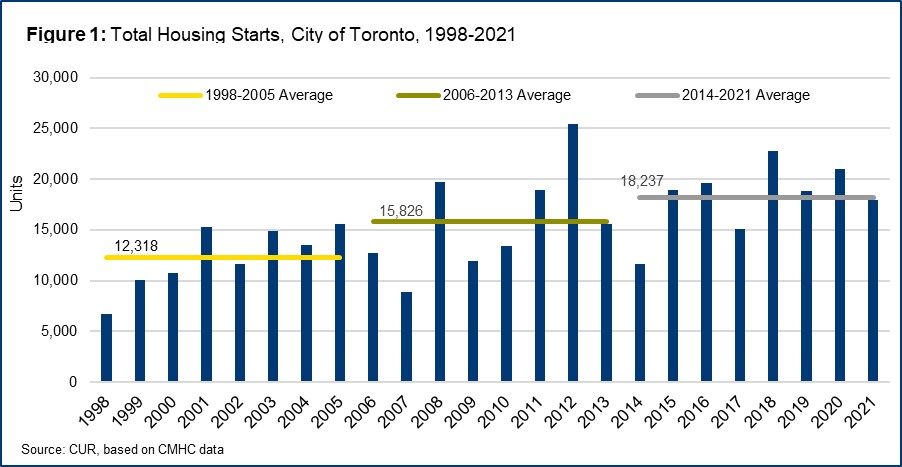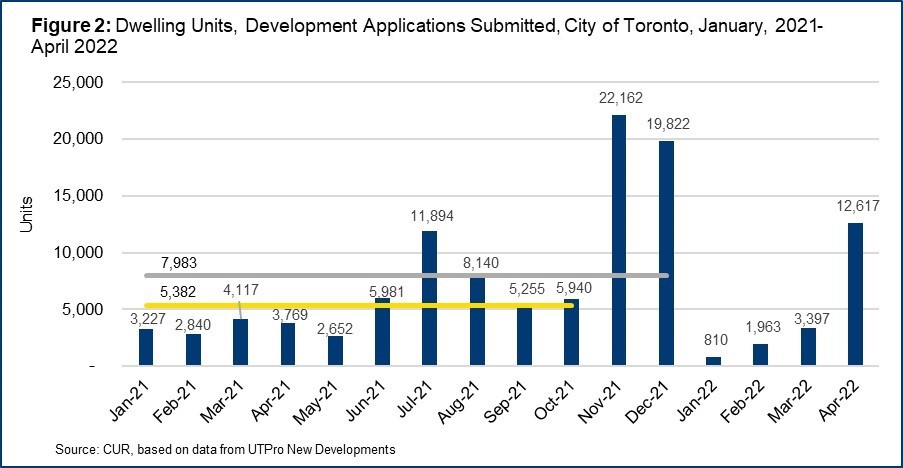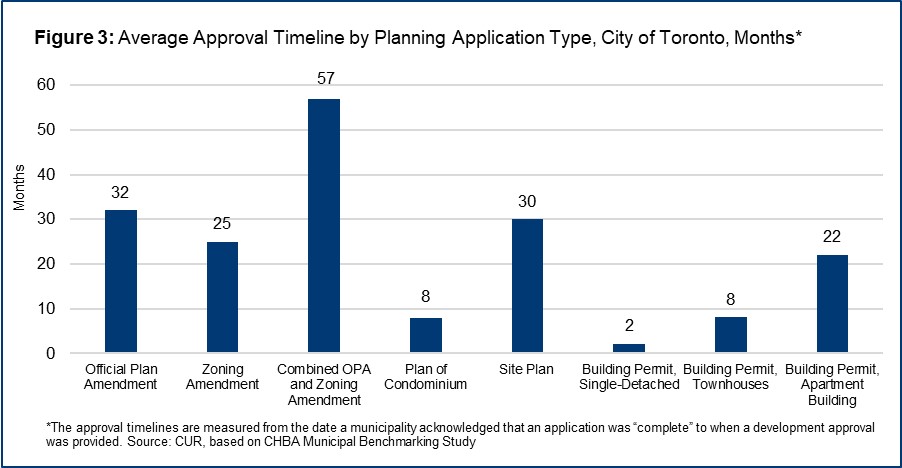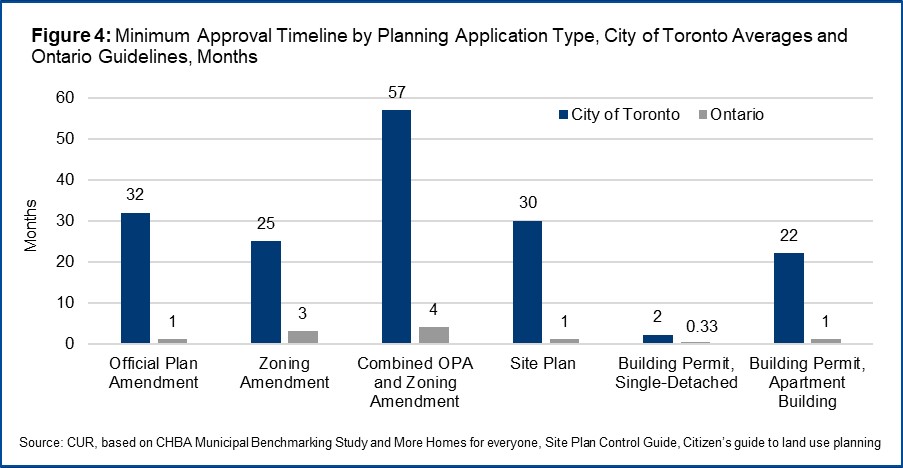The City of Toronto Has the Potential to Significantly Increase Its Annual Housing Production if Council and Staff Get on Board
By: Frank Clayton with research assistance from Nigel Alphonso
July 12, 2022
(PDF file) Print-friendly version available
Housing affordability has become a problem for an increasing number of people in the city of Toronto and throughout the larger region. It is important to consider the supply side of this issue. While housing starts in Toronto have been trending upward over the past 25 years, they have not kept up with demand. The number of development applications submitted to the City of Toronto in the past year shows that there is potential for considerably more starts; however, Altus Group’s Municipal Benchmark Study has documented lengthy approval timelines for multiple application types. This bottleneck is a major contributor to the supply shortage in the city. Housing affordability should be a top priority for Toronto’s City Council (“Toronto”) as they have the power to drastically shorten the application process by meeting or even beating provincial timing guidelines, thus increasing the supply of ready-to-go sites for new housing.
Background
Urban Toronto has initiated a subscription service, UTPro, which provides detailed information on development applications submitted to Toronto from January 2021 to April 2022 through the release of a monthly synopsis.1 This data release shows the scale of interest by the development industry as it tracks the number of dwelling units requested in the applications submitted, even if there is no guarantee that these applications will be approved or approved without revisions.
In this blog, we examine three data sets pertaining to Toronto: housing starts (CMHC), development applications (Urban Toronto), and average timelines for processing applications at various stages of the planning review process (Altus Group). 2
As seen in Figure 1, which shows annual housing starts in Toronto for the past 24 years, the trend in housing starts is upward. Since the annual data are volatile, we have created annual averages for three eight-year periods.

It is evident there has been an increase in the number of starts in Toronto over the past 24 years. Average annual starts have risen from 6,759 units in 1998 to 17,959 units in 2021, a 166% increase.
The question arises: given the strength of demand for housing in the city, why did housing starts not increase more?3
Development applications, an indicator of the future supply of housing projects, were extremely buoyant in 2021. Figure 2 shows the monthly development applications submitted to the city for new housing, beginning in January 2021.

There was a significant number of units proposed in the applications submitted in 2021 - a total of 95,799 units for an average of 7,983 per month. These units amount to 5.3 times the starts in 2021.
However, something unique happened in the last two months of the year when applications escalated. Urban Toronto says it was due to developer concerns about proposed inclusionary zoning rules. Thus, the activity in the first ten months of the year is more representative of the underlying level of developer interest in facilitating new projects. If the latter two months of 2021 had applications submitted equal to the monthly average between January and October, the annual total units submitted would have been 64,584. This is still more than triple the average level of recent starts seen in Figure 1. Applications accelerated again in April 2022 in advance of toughened sustainability rules by the City coming into effect.
Maneuvering through the approvals process is typically a lengthy procedure in Toronto. Timelines for various application types found by Altus Group’s Municipal Benchmark Study are shown in Figure 3 below.

Planning applications in Toronto can take years to be approved, as the process is among the longest in the country. This is a key reason for the discrepancy between the units in applications submitted and starts in the city.
These timelines are much lengthier than the limits put forth by the Province of Ontario.4 Figure 4 below compares the two sets of timelines.

Toronto currently takes years to approve many applications. However, if Council followed provincial guidelines, timelines would be significantly reduced.
In fairness, there are several initiatives underway at the city, provincial and federal levels to expedite the approval process. These include the City's Concept 2 Keys (“C2K”) initiative, provincial funding to incorporate technology to improve municipal approvals, and the Bill 109 provisions to streamline the approvals process. There are also expectations that the Federal/CMHC Accelerator Fund will provide funding to help speed up the approval process. Still, much more is needed to have a material impact.
Bottom Line
If Toronto prioritized the provision of new housing by simplifying the approval process and accelerating the review of applications, the City could see a significant increase in its number of annual starts. This increase could help ease the affordability difficulties so many are facing today. The only thing holding starts back is Toronto itself.
Sources:
[1] If you are interested in the data used to generate this report, you can get more details about the UTPro subscription database service on the official UTPro page (external link) . For more information about UTPro, contact Edward Skira at Urban Toronto.
[2] CMHC (2020). ‘Housing Starts, Completions and Units Under Construction, January-December 2019.’ [Online] Available: https://www.cmhc-schl.gc.ca/en/professionals/housing-markets-data-and-research/housing-data/data-tables/housing-market-data/housing-starts-completions-units-under-construction-cumulative (external link) ; Toronto (2021). ‘Introducing UrbanToronto Pro: A Dynamic New Tool That Will Save Valuable Time and Generate Business Leads.’ [Online] Available: https://urbantoronto.ca/news/2021/10/introducing-urbantoronto-pro-dynamic-new-tool-will-save-valuable-time-and-generate (external link) ; and CHBA (2020). ‘Municipal Benchmarking Study.’ Altus Group. [Online] Available: (PDF file) https://www.chba.ca/CHBADocs/CHBA/HousingCanada/Government-Role/2020-09-21-Report-CHBA-Municipal-Benchmarking-Study.pdf (external link) .
[3] It is estimated that the Toronto region had a shortfall in the amount of new housing built of over 70,000 units since 2006. Will Dunning (2021). “Not Enough Places to Live: Housing Production in Canada Has Fallen Far Short of the Needs of Our Growing Population.” [Online] Available: (PDF file) https://www.wdunning.com/_files/ugd/ddda71_2ad70269943d4b0e92de78697c6c7213.pdf (external link) .
[4] Ministry of Municipal Affairs and Housing (2019). ‘More Homes, More choice; Ontario’s Housing Supply Action Plan.’ [Online] Available: (PDF file) https://files.ontario.ca/mmah-housing-supply-action-plan-21may2019.pdf (external link) ; Ministry of Municipal Affairs and Housing (2021). ‘Site Plan Control Guide.’ [Online] Available: https://www.ontario.ca/page/site-plan-control-guide (external link) ; and Ministry of Municipal Affairs and Housing (2019). ‘Citizen’s Guide to Land Use Planning.’ [Online] Available: https://www.ontario.ca/document/citizens-guide-land-use-planning (external link) .
Frank Clayton, Ph.D., is Senior Research Fellow at Toronto Metropolitan University’s Centre for Urban Research and Land Development (CUR) in Toronto.
Assistance provided by Nigel Alphonso, Research Assistant at Toronto Metropolitan University’s Centre for Urban Research and Land Development (CUR) in Toronto.